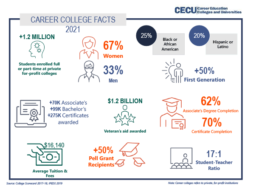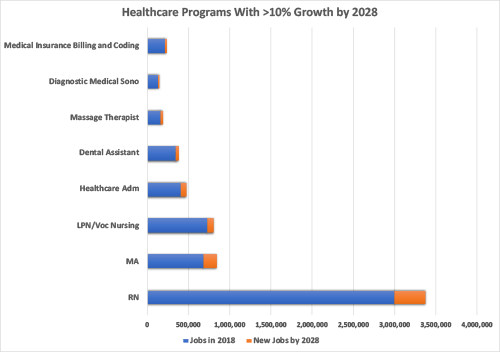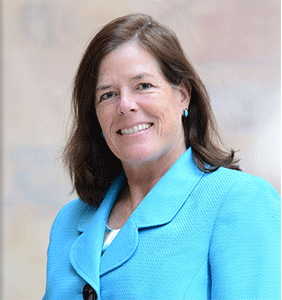
Increasing Demand for Healthcare Professionals – Demographics, Trends and Opportunities
By Elizabeth Keifer Herron, VP – Solutions & Sales, Collegiate Admission and Retention Solutions (CARS)
Demographics and trends
Changing demographics in the United States are driving tremendous opportunities for employment in healthcare professions. According to the Bureau of Labor Statistics (BLS), healthcare support and practitioner jobs account for more than half of the projected fastest-growing occupations from 2018 to 2028. The Occupational Outlook Handbook (BLS, Sept. 4, 2019) reveals that home health aides, personal care aides and occupational therapy assistants rank in the top five. Further, physician’s assistants, nurse practitioners, physical therapy aides and assistants, phlebotomists and medical assistants are all in the top 20 fastest-growing occupations.
There are several demographic trends contributing to the need for more healthcare professionals, but at the top is the fact – Americans are living longer due to advancements in nutrition, medical care, research and treatment for illness and disease.
The U.S. Census Bureau’s 2017 Population Projection indicates that by 2034, the number of people 65 and older will surpass the number of children under 18 for the first time in history.
In addition to increases in life expectancy, our aging population can be attributed to a decrease in the number of infant births. According to the Center for Disease Control’s Vital Statistics Rapid Release (CDC, May 2019), 2018 marks the fourth consecutive decrease in birthrates and reveals the lowest number of births in 32 years. According to the CDC report, we would need each woman to give birth to 2.1 children to keep the population steady, but our current rate has dropped to 1.8. This also means that in many extended families, there are not younger people to help care for the elderly. In an article for www.visualcapitalist.com, Jeff Desjardins writes, “According to the Population Reference Bureau, aging Baby Boomers could mean a massive 75% increase in the number of Americans requiring nursing home care, from 1.3 million in 2010 to 2.3 million in 2030.” (https://www.visualcapitalist.com/us-population-pyramid-1980-2050/)
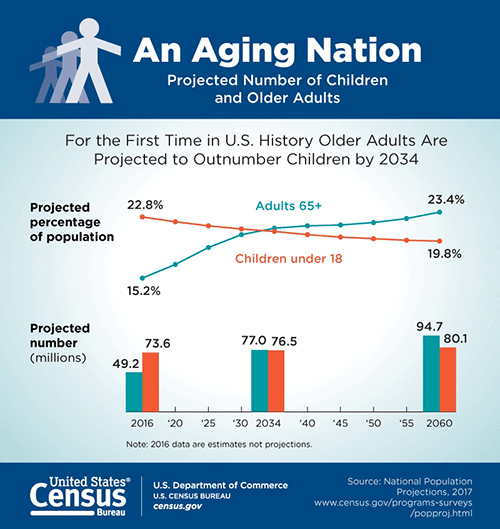
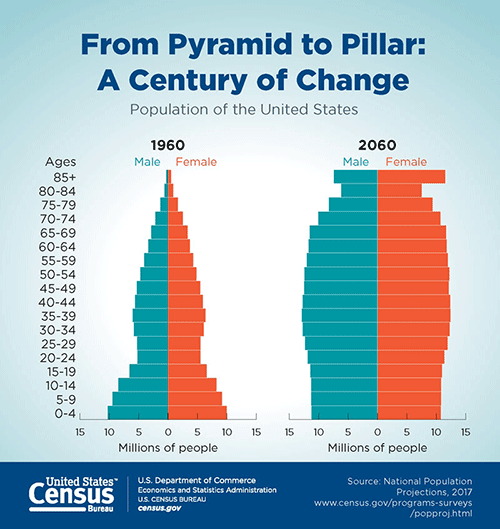 With increased longevity, we also note a trend with regard to employment after 65. According to the Population Research Bureau, the number of men and women over 65 who continue to work is on the rise. In 2017, 37% of men and 28% of women over 65 continued to work, representing the highest percentages since the late 1960s. Staying in the workforce can be more demanding for older people and may increase the risk of illness or injury, resulting in an increased utilization of health services, especially occupational and physical therapy.
With increased longevity, we also note a trend with regard to employment after 65. According to the Population Research Bureau, the number of men and women over 65 who continue to work is on the rise. In 2017, 37% of men and 28% of women over 65 continued to work, representing the highest percentages since the late 1960s. Staying in the workforce can be more demanding for older people and may increase the risk of illness or injury, resulting in an increased utilization of health services, especially occupational and physical therapy.
Opportunities
Spending on healthcare in the U.S. is rising faster than any segment of the economy. In an article in the Journal of American Medicine, Joseph Dieleman writes, “Total health spending in 2015 reached $3.2 trillion and constituted 17.8% of the U.S. economy. Even after adjusting for inflation, the annualized growth rate in U.S. healthcare spending between 1995 and 2015 was 4.0%.” The growth rate for the U.S. economy during roughly the same time period was only 2.4%. (https://jamanetwork.com/journals/jama/fullarticle/2661579).
Despite slightly different credentialing and licensing requirements for some healthcare professions, the skills remain portable and in high demand nationwide, making them incredibly versatile in the increasingly mobile population. The chart below uses data from the BLS Occupational Outlook Handbook for specific program growth areas. These programs are among those with the highest percentage of growth from 2018 to 2028, resulting in a tremendous demand for education and training to support the occupational outlook.
Inquiries for enrollment into healthcare-related programs continues to rise, and institutions are growing to meet the demand. Creative partnerships with hospitals and medical facilities help institutions meet their need for internship and externship sites, while providing critical labor for the employer’s growing demands. Although many of the fastest-growing occupations with the highest demand are not high-paying, they provide flexible hours and abundant opportunities, making them the perfect fit for many individuals.
While the outlook is optimistic across healthcare professions, will artificial intelligence (AI) stymie this growth as it has in many other fields?
Artificial intelligence and healthcare
According to a study out of the Oxford Martin School at the University of Oxford, almost half of the occupations in the U.S. are at risk for computerization or job loss due to technology. Authors Carl Benedikt Frey and Michael Osbourne reviewed 702 different occupations to evaluate the susceptibility for computerization resulting in a reduction in jobs. The study identifies the types of jobs that are the least likely to be lost due to computerization, because humans can perform better than machines in three major areas:
- Perception and manipulation – Computers cannot compete with humans as it relates to perception or fine motor dexterity and working in tight spaces.
- Creative intelligence – Programmers have yet to capture the creativity and originality that comes from the human mind in AI.
- Social intelligence – While much research is being done in this area, computers cannot match human capabilities in social interaction, caregiving/nurturing or persuasion.
Although most occupations in healthcare will be safe from a robotic takeover, there will be changes and developments affecting the way we teach and prepare individuals for careers in the healthcare professions. According to an article in the Harvard Business Review entitled, “AI Will Change Healthcare Jobs for the Better,” authors Wilson and Daugherty explore a variety of enhancements and improvements in healthcare, as automation and collaboration between humans and machines helps us to perform better. (https://hbr.org/2018/03/ai-will-change-health-care-jobs-for-the-better) The study references three main areas of improvement and growth.
- Amplifying people’s natural abilities – improvements in the accuracy of pathology – AI-based technique can identify breast cancer cells more accurately, improving accuracy from 96 to 99.5% – 130,000 more women receiving an accurate diagnosis in a year
- Interacting with people through novel interfaces – voice, emotion or gesture recognition – use of robots, chatbots and screening tools can reduce overburdened caregivers and improve productivity
- Smart machines extend people beyond their natural limits – robot assisted surgery or robots to assist with routine or heavy tasks
Private institutions are uniquely positioned to grow and enhance curriculum and offerings to anticipate areas of growth and new interfaces with technology. At the same time, a strong focus on developing critical soft or personal skills will continue to make humans integral to the healthcare network. Creative industry partnerships result in exposure to the latest advancements, giving private school students an edge over students coming out of public institutions. Finally, more frequent starts and shorter program duration will continue to provide students attending private institutions advantages in the growing healthcare workforce.
Resources
- https://www.census.gov/programs-surveys/popproj.html
- https://www.bls.gov/ooh/fastest-growing.htm?view_full
- https://www.cdc.gov/nchs/data/vsrr/vsrr-007-508.pdf
- https://www.prb.org/will-more-baby-boomers-delay-retirement/
- https://www.oxfordmartin.ox.ac.uk/downloads/academic/future-of-employment.pdf
ELIZABETH KEIFER HERRON is a senior member of the executive management team at CARS. Her multiple responsibilities include oversight and management of CARS’ placement verification service, client support, community outreach, as well as chief compliance specialist. Serving on numerous higher education associations’ committees, she is a respected and frequent presenter at many industry workshops and conferences. Calling Washington, DC her home enables Elizabeth to access up-to-the-minute information on a variety of legislative and regulatory issues affecting the post-secondary community. A founding member of the CARS’ family of companies, Elizabeth received her BA with honors in Political Science and Economics from Douglass College of Rutgers University and her prior experience includes chief lobbyist for the Career College Association (now CECU).
Contact Information: Elizabeth Keifer Herron // Vice President – Solutions & Sales // Collegiate Admission and Retention Solutions (CARS) // ekherron@collegiatersvp.com // 202-558-2337 // www.collegiatersvp.com // https://www.linkedin.com/in/elizabeth-herron-446595/


